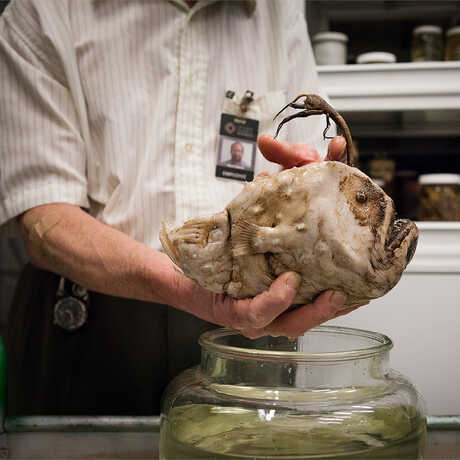Larger Pacific Striped Octopus

This animal is not currently on exhibit at the aquarium.
The larger Pacific striped octopus is one of the most exciting scientific discoveries that almost wasn’t. First described in 1991, the species was initially dismissed by the zoological community on the grounds that it was too bizarre to be real—that’s how much its behaviors fly in the face of nearly everything we know about cephalopods. Only in early 2013, when the creature was displayed in public for the first time, right here at the California Academy of Sciences, were early findings validated.
Much of the astonishing novelty of the larger Pacific striped octopus comes from its reproductive life. For instance, while most octopuses are cannibalistic, and have to exercise extreme caution while mating, these octopuses mate with their ventral sides touching, pressing their beaks and suckers together in an intimate embrace. (Nobody gets eaten.) And while most female octopuses die shortly after laying their first clutch of eggs, mothers in this species can mate and gestate many times throughout their lives.
The LPSO is unusually social as well, apparently content to live in close proximity with a few dozen of its kind, but we still have much to learn about its behavior and activities, both social and solo. In particular, its knack for dramatic changes in color and shape—turning quickly from dark red to black and white with stripes and spots—may hold some new clues to the workings of cephalopod communication.
Range
To date, the larger Pacific striped octopus has been observed only in a small handful of locations off the coast of Nicaragua, in murky intertidal waters close to the mouths of rivers. For all we’re learning about this species in captivity, its life in the wild is a topic with even further opportunity for discovery.
Difficult to Describe
The larger Pacific striped octopus was observed near Nicaragua in the late 1970s by Panamanian biologist Aradio Rodaniche. Rodaniche submitted an abstract to the Bulletin of Marine Science in 1991, but the creature he described was so unusual that the paper didn’t pass peer review—so the LPSO remained obscure for another two decades, until two California scientists working on the lesser Pacific striped octopus, the Academy's Richard Ross and UC Berkeley's Roy Caldwell, found Rodaniche and brought the new species to light.
At the Academy
Because the larger Pacific striped octopus is so rare, Academy Senior Biologist Rich Ross is working to develop a way to raise octopus hatchlings to full-fledged, breeding adults. Raising larval marine animals is an extremely difficult task, so Ross has been breeding and rearing the species—two females and three males so far—in a 100-gallon tank in his home in Alameda, California. (He notes that they’re very picky eaters.)
Be mesmerized by colorful coral reef fish, soaring stingrays, and adorable African penguins—streaming live to your device, 24/7.






